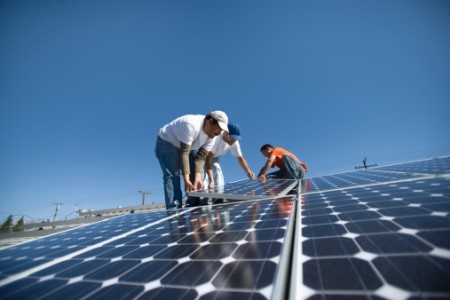Solar Trade Case and Tax Reform Threaten the Industry

At this month’s Solar Power International conference in Las Vegas on Sept. 10-13, one topic dominated the general sessions and education panels: the Section 201 trade case brought by Suniva, a bankrupt United States manufacturer, to the United States International Trade Commission (ITC).
Suniva filed a petition with the ITC to support a four-year, $0.40/ W tariff and $0.78/W minimum import price on all imported solar panels. The manufacturer claimed that foreign manufacturers flooding the United States solar market led to its bankruptcy. However, the trade case could result in greater harm to the entire solar industry. According to Solar Energy Industries Association (SEIA), doubling the cost of solar panels in some cases is expected to cause 47 GW of lost opportunity over five years.
This slowdown is already apparent as tax equity investors are hesitant to close new deals destined to reach commercial operation in 2018. Meanwhile, the threat of federal tax reform also looms on the horizon.
Is Suniva’s Case Substantiated?
Since Suniva’s original filing with the ITC in April, SEIA, the solar trade association led by President and CEO Abigail Ross Hopper, has stepped up to be the face of the opposition. SEIA has said 67 percent of solar jobs do not require bachelor’s degrees. It has also said 88,000 solar jobs will be negatively impacted if President Trump ultimately sides with Suniva. The majority of solar jobs include racking and/or mounting work. Demand for this type of work will decrease if panel prices increase dramatically.
During the first SPI general session on Monday, Hopper was joined on stage by three solar manufacturers.
Ed Fenster, executive chairman of Sunrun, said Suniva refused to participate in quality assurance programs despite a relatively low recall rate across the industry.
Bill Vietas, president of RBI Solar, said that while Suniva panels represented only 3 percent of installs in the United States, the company is holding the entire national solar industry hostage with the threat of an additional import tariff.
George Hershman, senior vice president and general manager of Swinerton Renewable Energy, said his company looked into procuring Suniva panels for a 700 MW project in Oregon. However, all of the panels ultimately used were manufactured in Thailand because Suniva simply could not produce the volume that project developers demanded.
The panelists agreed that unlike previous trade cases, which the Obama Administration honored with tariffs targeting imports from China and Taiwan, the current petition could not prove that imports are indeed flooding the United States market.
Further, the law states that petitioners must also submit a plan that outlines how they plan to be competitive if granted relief. As of the time of this writing, Suniva has not provided a plan.
What Are the Financial Implications of the Solar Trade Case?
The uncertainty around panel pricing impacts tax equity investors, too. In terms of timing, the tariff on imports could go into effect within 15 days of a determination by the White House.
During a panel on tax equity, Mit Buchanan, managing director at J.P. Morgan & Co., confirmed that the threat of panel price increases has meant that no agreements are currently being signed for 2018.
Jonathan Silver, managing partner at Tax Equity Advisors, said the trade case is also impacting the due diligence process. Due diligence for a renewable energy project involves reviewing all project deal documents with a fine-toothed comb. This process is intended to identify and mitigate potential risks.
Silver said we are now seeing power-purchase agreements (PPAs) that include clauses addressing panel procurement.
Ultimately, “the [project] sponsor is carrying that risk,” said Britta von Oesen, a director at CohnReznick. She also said there is discussion of PPAs’ performance with and without tariffs.
As a hedge against changes in panel pricing, some developers are hoping to buy up as many panels as they can now.
What about Changes to Tax Policy?
In addition to the Suniva case, there is uncertainty around the future of tax policy. Secretary of the Treasury Steven Mnuchin has been calling for a $2 trillion USD tax cut.
What does a corporate tax cut have to do with renewable energy financing? At present, organizations with large incomes (and therefore large tax liabilities) can partner with a renewable energy company to provide capital to build the project while taking advantage of the tax benefits. With a diminished tax liability, the tax equity-investor pool shrinks.
Some experts predict lower rates of return as well. According to Darren Van’t Hof, director of production of renewable energy investments at US Bank, tax equity investors need to be comfortable with internal rates of return that are under 10 percent.
Buchanan admitted to using a 25-30 percent assumption for J.P. Morgan & Co.’s 2018 projections and indicated some government officials hinted that 22.5 percent could also be a possibility.
Jonathan Silver was in the minority in the room; he said he believed a tax cut could be passed and become effective in 2017.
Join our LinkedIn group to discuss this article. You may also email the author directly using our contact form.
